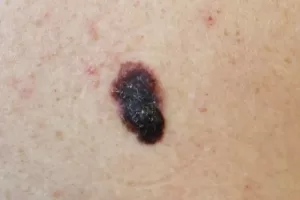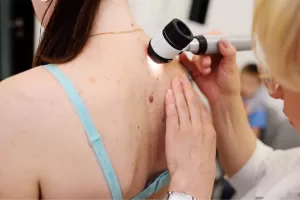What are the symptoms of Melanoma?
Medically Reviewed by Dr Richard Bennett
Last updated on 11.06.2024
What is Melanoma?
Melanoma is a serious form of skin cancer. It tends to occur in parts of the body that are regularly exposed to the sun, though less commonly it can develop in areas that don’t usually get sun exposure (for example, the soles of the feet). Melanoma is very common in Australia- in fact Australia and New Zealand have the highest rates of Melanoma in the world.
How common is Melanoma?
- Around 5 Australians die from Melanoma every day.
- The risk of being diagnosed with Melanoma throughout life is 1 in 14 for men and 1 in 24 for women.
What causes Melanoma?
Melanoma is when certain pigment-producing cells in the skin called “melanocytes” start to multiply abnormally and become cancerous. The following issues can lead to a higher risk of Melanoma:
- UV (ultraviolet) rays in sunlight cause damage to melanocytes, leading them to develop genetic defects and become cancerous. People who were frequently sunburned as children or who have had a lot of unprotected sun exposure over the years thus have a higher risk. Using sunbeds or solariums can also increase the risk in the same way.
- People with fair or freckly skin that burns easily, as well as people with light hair and eye colour are at higher risk.
- Some people have large numbers of unusual moles or “dysplastic naevi” which can develop into Melanoma.
- A weakened immune system
- Family history of Melanoma (in a first degree relative such as a parent or sibling)
- Previous skin cancer – Melanoma or other forms of skin cancer
What does Melanoma look like?
Any skin lesion that has the following features should be checked by a doctor as it can be a sign of Melanoma:
- Getting darker or changing colour
- Getting bigger
- Becoming raised or changing shape
- Becoming itchy or bleeding
- Developing edges that are irregular or spiky in appearance
- Any new mole or unexplained skin lesion that develops in adulthood
While a Melanoma usually develops on the skin, it can also happen in other tissues, such as under a fingernail or toenail, on the pink tissue that lines parts of the body such as the mouth, vulva, anus or even in the eye. Whilst Melanomas are usually dark brown or black, less commonly they can be other colours, such as pink, purple, red, blue, skin-coloured or white.
What is the ABCDE method?
The ABCDE method is a good way to remember the warning signs for Melanoma.
- A – Asymmetry (an irregular-shaped mole or skin lesion)
- B – Border (the edges of the skin lesion become irregular)
- C – Colour (the lesion starts to change in colour)
- D – Diameter (Melanoma is usually more than 6mm in diameter- though any lesion that is getting bigger should be checked)
- E – Evolving (if the lesion is changing and growing).
How is Melanoma diagnosed?
- Your doctor may be able to tell by asking questions and looking at the lesion.
- They may use a dermascope (a special type of magnifying glass) to take a more detailed look
- A biopsy may be recommended, which will be analysed by a pathologist.
What is the treatment for Melanoma?
- Melanoma is usually removed surgically by a skin specialist- if it is recognised and treated early, it is a very curable condition.
- A certain amount of tissue needs to be removed around the lesion to make sure no abnormal cells are left behind- the amount depends on the thickness (depth) of the Melanoma and whether it has spread elsewhere.
- Sometimes lymph nodes (glands) need to be surgically removed too.
- If Melanoma has spread to other parts of the body, such as bone, brain or lungs, treatment may involve surgery, radiotherapy and/or immunotherapy (special medications that help the immune system fight the cancer cells)
- If Melanoma is advanced and has spread to other parts of the body, treatment may be palliative- i.e. aimed at maximising quality of life rather than cure, by reducing pain or other symptoms.
If you have concerns about Melanoma or if you’re worried about a skin lesion, speak to your GP or dermatologist.
Further patient resources:
Getting a Mental Health Care Plan in Australia: Your Guide
Getting a Mental Health Care Plan in Australia: Your Guide Mental health matters—and if you’re feeling overwhelmed, anxious, or down, a mental health care plan can help. But what is it, and how do [...]
UTI Symptoms and Treatment: What You Need to Know
UTI Symptoms and Treatment: What You Need to Know Urinary Tract Infections (UTIs) are common, uncomfortable, and often disruptive. But what exactly are the signs to watch for, and how can you get relief [...]
Free Mental Health Care Plan Online | Bulk-Billed by Qoctor
Free Mental Health Care Plan Online | Bulk-Billed by Qoctor Discover how to get a free, bulk-billed Mental Health Care Plan (MHCP) in Australia through Qoctor's telehealth service. Accessing [...]






